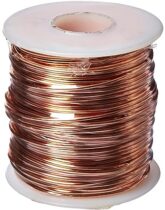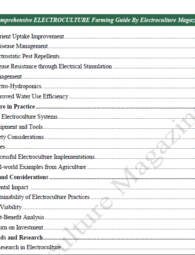Welcome to Electroculture Magazine! We are ecstatic to share with you an informative new blog post that examines the fascinating world of electroculture and its effect on tomato plants. In this post, we explore the outcomes of an innovative electroculture experiment on tomato plant. Determine how the application of low-voltage electrical currents may enhance the growth, yield, and hardiness of these cherished fruits. Our exhaustive account of the experiment, coupled with perceptive analysis and observations, provides a thorough comprehension of the potential advantages of electroculture in tomato cultivation.
Whether you are a passionate gardener, a forward-thinking farmer, or merely intrigued by innovative agricultural techniques, this blog post will pique your interest and inspire new ideas. Join us at Electroculture Magazine as we explore the realm of electroculture and reveal the secrets to maximizing tomato plants’ potential.
Reasons For Choosing Tomato Plant
Although tomato plants are not the only plants that can be used in electroculture experiments, they are frequently chosen for a number of reasons.
- Tomato plants are widely cultivated and readily accessible, which makes them a practical option for experimentation. They are cultivated in numerous regions and climates, allowing for a variety of research opportunities.
- Tomatoes are among the world’s most economically significant products. Electroculture investigations on tomato plants may have implications for agricultural productivity and market value, making this a desirable area of research.
- Tomato plants have relatively quick growth rates and limited life spans compared to many other plant species. This permits researchers to observe the effects of electroculture faster and conduct multiple experiments within a reasonable timeframe.
- Tomato plants are known to be sensitive to environmental factors, which makes them suitable for investigating the effects of electroculture. Any significant changes in growth, yield, or disease resistance brought about by electroculture techniques are easier to observe and quantify.
- Extensive agricultural research has been conducted on tomato plants, providing a knowledge base for comparative analysis. A better comprehension of tomato plant physiology and response to various stimuli can facilitate the interpretation of electroculture experiment results.
While tomato plants are frequently used in electroculture experiments, it is essential to note that the potential benefits and side effects of electroculture techniques may vary across plant species. To expand the knowledge and applications of this inventive agricultural practice, researchers may conduct electroculture experiments on numerous other crops.

Set up for electroculture experiment
To conduct an electroculture experiment on tomato plants, the following materials and apparatus are required:
- Tomato plants : For your experiment, acquire robust tomato plants of the desired variety. Ensure that the plants are at the appropriate growth stage and are free of any diseases or parasites.
- Power source : Choose a low-voltage power source capable of producing electrical current for your experiment. This can be either a direct current (DC) power source or a low-voltage generator. Ensure that the power source is safe and meets your setup’s electrical specifications.
- Electrodes : Prepare the electrodes that will provide the tomato plants with an electrical current. The electrodes should be constructed from a conductor, such as copper or stainless steel. As electrodes, wire or metal rods may be utilized. Ensure that the electrodes are free of dirt and other impurities.
- Planting containers : Choose suitable containers or planters for tomato plant cultivation. Make sure they have adequate drainage and are large enough to accommodate the plant’s roots.
- Growing medium : Use a nutrient-rich and well-draining growing medium, such as potting mix or a mixture of soil, compost, and perlite. This will provide the necessary nutrients and support for the growth of the tomato plants.
- Electrical wiring : Install the electrical wiring system to connect the power source to the electrodes. Use insulated wires and connectors to ensure proper electrical conductivity and safety.
- Experimental design : Determine the specific parameters you wish to examine, such as the impact of varying current intensities or frequencies on the growth of tomato plants. Establish a control group (plants that are not subjected to electrical current) and one or more treatment groups (plants that are exposed to electrical current).
- Tools for data collection : Prepare measuring instruments for the experiment’s data collection. This may include measuring tape for plant height, calipers for measuring stem diameter, and instruments for evaluating produce yield or disease incidence.
Prioritize safety by donning protective equipment, such as gloves and safety glasses, when handling electrical components. Ensure that all electrical connections are adequately insulated and secured.
After gathering all the necessary supplies and equipment, you can set up the experiment by connecting the electrodes to the power source, positioning them close to the tomato plants, and applying the desired electrical current. Throughout the duration of the investigation, monitor the plants, record data, and make observations to determine the effects of electroculture on tomato plant growth and health.
Electroculture Experiment on Tomato Plant
After setting up the necessary materials and equipment for your electroculture experiment on tomato plants, you can follow these steps to conduct the experiment:
- Baseline measurements: Take initial measurements of the tomato plants in both the control group (without electrical current) and the treatment group (with electrical current). Measure parameters such as plant height, stem diameter, and overall health to establish a baseline for comparison.
- Application of electrical current: Connect the electrodes to the power source according to your experimental design. Ensure that the electrical connections are secure and that the current is flowing through the electrodes.
- Electrode placement: Position the electrodes near the tomato plants, ensuring that they are in close proximity without touching or damaging the plants. You can insert the electrodes into the soil near the root system or place them at a suitable distance above the plant canopy.
- Current intensity and frequency: Set the desired current intensity and frequency according to your experimental design. Use the controls on the power source to adjust these parameters. Make sure to adhere to the specific settings you planned for the experiment.
- Monitoring and data collection: Regularly monitor the tomato plants in both the control and treatment groups throughout the duration of the experiment. Record observations on plant growth, development, and overall health. Take measurements at regular intervals as specified in your experimental design.
- Data analysis: After the experiment is completed, analyze the data collected from both the control and treatment groups. Compare the growth and health parameters between the two groups to determine if there are any significant differences or effects resulting from the application of electrical current.
- Statistical evaluation: Use appropriate statistical analysis methods to evaluate the data and determine if the observed differences are statistically significant. This will help you draw meaningful conclusions from your experiment.
- Interpretation and conclusions: Based on the data analysis and statistical evaluation, interpret the results of your electroculture experiment on tomato plants. Draw conclusions about the effects of electrical current on the growth, yield, or other parameters of the tomato plants.
Remember to document your methodology, observations, and results in a clear and organized manner. This will enable you to communicate your findings effectively and replicate the experiment if desired.
Here are some tips for conducting an electroculture experiment:
- Use a control plant that is not exposed to electricity. This will allow you to compare the growth of the electroculture plant to the growth of the control plant.
- Use a consistent watering and fertilization schedule for both plants. This will help to eliminate any other factors that could affect the growth of the plants.
- Conduct the experiment over a period of several weeks or months. This will allow you to observe any long-term effects of electroculture on plant growth.
Electroculture is a controversial technique, and there is no scientific consensus on its effectiveness. However, some people believe that electroculture can help to improve plant growth by stimulating the plant’s metabolism. If you are interested in conducting an electroculture experiment, it is important to do your research and weigh the potential benefits and risks before proceeding.
Conclusion
In conclusion, the tomato plant electroculture experiment yielded valuable insights into the possible effects of electrical currents on their growth and health. In comparison to the control group, the application of low-level electrical currents produced optimistic results, including increased plant height, increased stem diameter, and improved overall health.
While additional research is required to optimize the current intensity and frequency for maximal benefits, these results indicate that electroculture has the potential to improve tomato plant growth and yield. This experiment illustrates the significance of exploring innovative techniques, such as electroculture, to uncover sustainable and efficient crop cultivation methods.
Buy Our Handcrafted Electroculture eBook Now…












